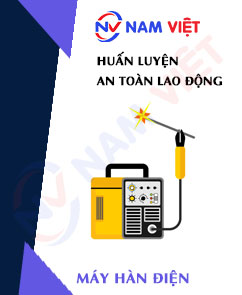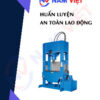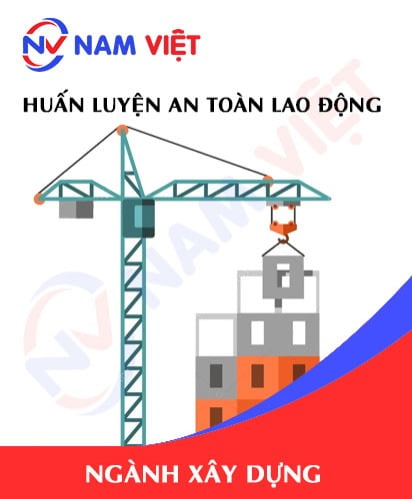Occupational safety training for operating electric welding machines
99,000 ₫
Note: The above price is calculated per person. Prices may vary depending on the number of participants in the course and market fluctuations. For more accurate pricing information, please refer to the pricing table or contact our consulting staff directly.
Occupational safety is an important issue when operating electric welding machines and must be addressed promptly to ensure the health and safety of workers and enhance the reputation of businesses here. The Occupational Safety Training course is one of the effective solutions to raise awareness among workers on how to prevent workplace accidents when operating electric welding machines.
Table of Contents
Toggle1. Overview of Electric Welding Machines
a. What is an Electric Welding Machine?
An electric welding machine is a device used in the process of welding metals. Welding metals involves joining two or more pieces of metal by heating them to a high temperature until they melt and then allowing them to cool to form a solid bond.
An electric welding machine is an electronic or electromechanical device used to generate the heat required for welding metals. It works by producing a strong electric current through a specific point on the metal surface, generating enough heat to melt the metal, which then solidifies to create a welded joint. Electric welding machines can operate on single-phase or three-phase power, depending on the machine type and specific application.
There are various types of electric welding machines such as stick welders, TIG welders, MIG welders, and plasma welders, each with its own applications and features. Electric welding machines are commonly used in industries such as construction, metal fabrication, automotive repair, and other applications requiring metal joining and repair.

b. Applications of Electric Welding Machines in Manufacturing
Electric welding machines are essential tools in many manufacturing processes. Some common applications include:
- Metal fabrication and manufacturing: Electric welding machines are widely used in fabricating metal components such as pipes, sheets, structural frames, and other metal products.
- Automotive manufacturing: In the automotive industry, electric welding machines are used to weld parts of vehicles such as car frames, door hinges, and exhaust systems.
- Electronics manufacturing: In electronics production, electric welding machines are used to weld electronic components on printed circuit boards, including surface-mount and through-hole soldering.
- Shipbuilding and marine products: Electric welding machines are used to weld parts and structures of vessels, including fishing boats and cargo ships, ensuring strength and safety at sea.
- Industrial equipment manufacturing: Machinery and industrial equipment are often welded from individual components using electric welding machines.
- Energy production: In the energy sector, electric welding machines are used to weld parts of equipment such as turbines, pipelines, and energy supply systems.
- Construction: In construction, electric welding machines are used to weld steel frames, iron doors, railings, and other components in buildings.
- Maintenance and repair: Electric welding machines are also used in repair and maintenance activities to rejoin or replace damaged machine parts.

c. Industries Using Electric Welding Machines
Electric welding machines are used across various industries, including:
- Metal Manufacturing: Possibly the industry that uses electric welding machines the most. They are used to weld metal components such as pipes, sheets, steel structures, and other metal products.
- Automotive Manufacturing: Used to weld vehicle parts such as frames, door hinges, and other metal components.
- Electronics Manufacturing: Used to weld electronic components on printed circuit boards and during the production of electronic devices.
- Food and Beverage Manufacturing: In some cases, electric welding machines are used to produce and seal food packaging and containers.
- Energy Industry: Used to work on components and structures in the energy sector, such as welding pipelines or energy supply systems.
- Shipbuilding and Marine Industry: Used to weld parts and structures of vessels and marine products.
- Construction: Used to weld steel frameworks, iron doors, railings, and other metal components in construction projects.
- Industrial Equipment Manufacturing: Machines and industrial equipment are assembled and welded from separate components.
- Aerospace Manufacturing: Used in producing and maintaining aircraft and spacecraft components.
- Water and Wastewater Industry: Used to weld parts of water treatment systems and pipelines.
In conclusion, electric welding machines are versatile and essential tools used in numerous manufacturing sectors for welding and joining metals.
2. Overview of Safety Training Courses for Electric Welding Machine Operation
a. What is Occupational Safety Training?
- Occupational safety training for electric welding machine operation consists of lessons that raise awareness on preventing workplace accidents. Workers who work directly with electric welding machines belong to Group 3.
- The safety training course helps workers recognize and prevent hazards, reducing the risk of workplace accidents during their tasks.
REGISTER FOR OCCUPATIONAL SAFETY TRAINING
b. Training Duration
Initial Safety Training
- Total training time is at least 24 hours, including assessment time.
- 8 hours of theoretical lessons on policies and labor safety regulations
- 8 hours of theoretical lessons on basic occupational safety knowledge
- 4 hours of theoretical lessons on specialized training content
- 2 hours of practical lessons on specialized training content
- 2 hours of final theoretical exam
The safety training center schedules sessions based on worker availability. Typically, there are 6 sessions over 3 days if the company can allocate continuous training time.
Periodic Safety Training
- Before the occupational safety card expires, workers must undergo periodic safety training, with training time of at least 50% of the initial training duration.
Explanation: Total periodic safety training is at least 12 hours, including assessment time. Upon completion and passing the exam, the occupational safety card is renewed.
c. Training Content
| No. | TRAINING CONTENT | TRAINING DURATION (HOURS) | |||
| Total | Including | ||||
| Theory | Practice | Exam | |||
| I | Policies and Labor Safety Regulations | 8 | 8 | 0 | 0 |
| 1 | Overview of occupational safety and hygiene legal documents. | 6 | 6 | ||
| 2 | Standards and technical regulations on labor safety and hygiene. | 1 | 1 | ||
| 3 | Specific regulations by state agencies for new, expanded, or renovated facilities involving machinery, equipment, materials, and substances with strict safety and hygiene requirements. | 1 | 1 | ||
| II | Basic Knowledge of Occupational Safety | 8 | 8 | 0 | 0 |
| 1 | Basic knowledge of hazardous and harmful factors at the workplace. | 4 | 4 | ||
| 2 | Methods to improve working conditions. | 1 | 1 | ||
| 3 | Safety culture in production and business. | 1 | 1 | ||
| 4 | Rights and obligations of employers and employees; safety policies and regimes; functions and duties of safety and hygiene officers. | 1 | 1 | ||
| 5 | Safety rules, signs, instructions, use of safety equipment and personal protective equipment; first aid and occupational disease prevention skills. | 1 | 1 | ||
| III | Specialized Training Content | 6 | 4 | 2 | 0 |
| Comprehensive knowledge of machines, equipment, and hazardous substances; risk assessment and management; safe work procedures with machinery, equipment, and hazardous materials. | 6 | 4 | 2 | ||
| IV | Final Safety Training Exam | 2 | 2 | 0 | 0 |
| Total | 24 | 22 | 2 | ||
See more training content for 6 groups
d. Occupational Safety Card
After completing the safety training and passing the exam, workers are issued an Occupational Safety Card (commonly called Occupational Safety Certificate Group 3).
The Group 3 safety card shows the worker’s full name, date of birth, job, specific work environment, training duration, red seal, and signature confirming completion of the course.
According to Article 24, Clause 2 of Decree 44/2016/ND-CP, there are two cases:
- If the employer and employee have a labor contract, the employer must sign and stamp the safety card for the Group 3 worker after completing the training from a certified training unit and passing the exam.
- If the worker is freelance or temporary, without a labor contract, the training unit must sign and stamp the safety card after the worker completes the training and passes the exam.

3. Hazards When Operating Electric Welding Machines
Operating electric welding machines can pose many hazards if safety rules are not followed and proper training is not provided. Below are some common hazards when operating electric welding machines:
- Electric Shock Risk: Electric welding machines operate with high current, so users must always follow electrical safety rules to avoid electric shock. This includes using protective equipment such as insulating gloves and ensuring that electrical devices are not damaged or faulty.
- Fire and Explosion Risk: Welding can produce sparks and high temperatures. If not properly controlled, it can cause fires or explosions, especially near flammable materials. Using fire-resistant materials and following fire safety rules is essential.
- Infrared and Ultraviolet Radiation: Welding processes can generate infrared and ultraviolet radiation, which can harm eyes and skin. Users should wear appropriate protective goggles and clothing to protect themselves.
- Toxic Fumes: Welding can produce toxic gases from metals or welding additives. Users need to work in well-ventilated areas or use respiratory protection equipment.
- Accidents with Welding Tools: Welding tools can be heavy and sharp, posing high accident risks. Users should always follow safety rules when handling these tools and receive proper training.
- Noise Impact: Electric welding machines often generate high noise levels. Users should wear hearing protection, such as noise-cancelling headphones, to protect their ears.
- Machine Malfunctions: Welding machines may malfunction or break down. Users should know how to operate machines safely, check them before use, and report any issues to supervisors or technicians.
To ensure safety when operating electric welding machines, users should receive proper training, follow safety rules, and use appropriate personal protective equipment.

4. Measures to Control Workplace Accidents When Operating Electric Welding Machines
Controlling workplace accidents when operating electric welding machines is crucial to ensure the safety of workers and the work environment. Below are some measures:
- Training and Instruction: Provide comprehensive training on machine operation, safety rules, and emergency response. Ensure workers understand how to control and minimize risks.
- Use of Personal Protective Equipment (PPE): Ensure workers use all required PPE, including protective goggles, fire-resistant clothing, heat-resistant gloves, and safety shoes.
- Regular Machine Inspection: Conduct periodic inspections and maintenance of welding machines to ensure they operate safely. Report any malfunctions or defects to supervisors or technicians.
- Safe Work Environment: Keep the workplace clean, ventilated, and organized. Remove flammable materials and ensure no chemicals or toxic gases are present.
- Sparks and Fire Control: Use fire-resistant materials to shield work areas and ensure no flammable materials are near the welding machine. Use protective screens to contain sparks.
- Noise Control: Wear hearing protection like noise-cancelling headphones to reduce noise exposure from welding machines.
- Toxic Gas Control: In areas with potential toxic gases, use respiratory protection and ensure proper ventilation.
- Document and Welding Quality Management: Ensure welding documents and materials meet quality standards and are properly stored. Follow accurate welding procedures.
- Establish Safety Rules: Create and follow specific safety rules for each welding task, including spacing, positioning, and emergency power shutdown procedures.
- Emergency Planning: Prepare for incidents by developing response plans and having fire-fighting and first-aid equipment available.
- Regular inspection of welding machines to detect safety issues such as mechanical wear or malfunction, reducing the risk of workplace accidents.
5. Benefits of Occupational Safety Training
An Toan Nam Viet provides businesses with the following benefits after completing occupational safety training under Decree 44/2016/ND-CP regarding occupational safety and hygiene:
- Workers can identify potential workplace hazards and take preventive measures to avoid accidents.
- Businesses can establish risk prevention measures in production, operation, and maintenance processes.
- Reduce costs associated with workplace safety risks.
- Uninterrupted production increases productivity and product quality.
- Compliance with occupational safety laws, avoiding legal risks.
- Enhances credibility and professionalism, strengthening the company’s brand.
Nam Viet training courses are designed to help individuals prevent hazards that could lead to injury or death.
REGISTER FOR OCCUPATIONAL SAFETY TRAINING SERVICE
6. Customer Feedback After Completing Training
An Toan Nam Viet has years of experience supporting businesses across Vietnam, especially in the southern provinces. Our commitment to training has grown increasingly professional, fueled by positive feedback and constructive suggestions from our clients. Below are testimonials from partners we have served:
7. Occupational Safety Training Capabilities of An Toan Nam Viet
An Toan Nam Viet is a reputable occupational safety training center in Vietnam, conducting ongoing courses at factories, production facilities, and construction sites across all 63 provinces.
REGISTER FOR OCCUPATIONAL SAFETY TRAINING SERVICE
Occupational Safety Training License
- An Toan Nam Viet has been inspected and certified by the Department of Occupational Safety under the Ministry of Labor, Invalids, and Social Affairs, confirming our capacity to provide professional occupational safety training.

Training Materials
- Training materials are reviewed and approved to ensure accurate and effective knowledge transfer before use in safety courses.
- Our instructors follow standardized teaching methods developed by An Toan Nam Viet, based on expert research and experience, to maximize knowledge absorption for trainees.
Facilities
- Controlling classroom conditions improves training efficiency and knowledge retention.
- Our training facilities are spacious and meet standards for area, lighting, and training equipment.
8. National Reputable Safety Training Center
At An Toan Nam Viet, professional dedication to occupational safety training is a top priority. We carefully prepare every detail—tools, materials, curriculum, audio, and lighting—to ensure effective training.
Our instructors are experienced experts with research on hazards across industries and effective prevention methods. Their lectures are practical, vivid, and easy for workers to understand, aligned with Decree 44/2016/ND-CP.
Our training center is proud to provide professional and reputable occupational safety services with these advantages:
- Competitive training costs with guaranteed quality.
- Flexible training schedules aligned with company production.
- Quick certification procedures in compliance with law.
- Experienced instructors.
- Controlled classroom environment enhances teaching and learning efficiency.
- Lessons adapted to occupational safety needs of businesses.
- Dedicated and professional support for clients.

9. Additional Occupational Safety Training Materials
- Safety materials for operating electric welding machines (detailed)
- Electric and gas welding safety training materials
- Complete occupational safety training materials
- Occupational safety training test set
- Multiple-choice safety test for electric welding machine operation
- Slides for occupational safety training on electric welding machines
1 review for Occupational safety training for operating electric welding machines
No comments yet















phanminhhang341
Hài lòng với cách tổ chức lớp học